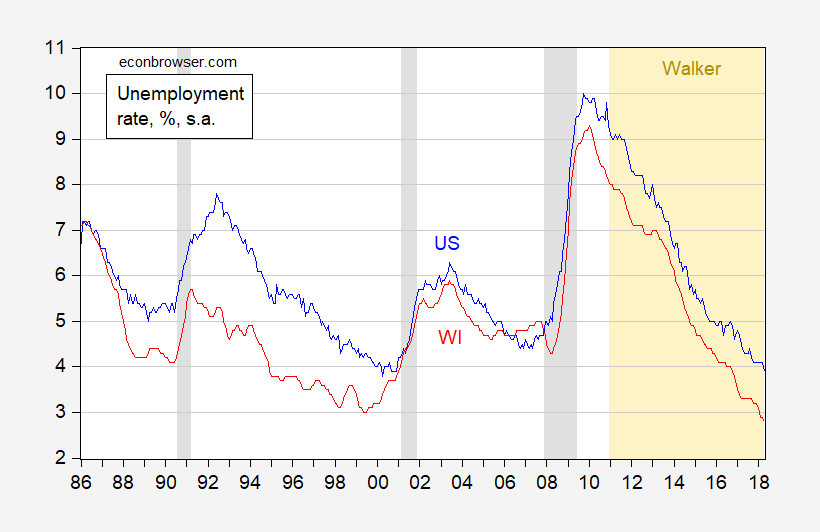Wisconsin’s unemployment rate has dropped to 2.8 percentage points in April. The national rate is 3.9 percentage points. Proof of Walkernomics success? Well, since on average Wisconsin’s unemployment rate is typically 0.9 percentage points below, the answer is “no”. Consider the Wisconsin and US unemployment rates.

Figure 1: Unemployment rate for United States (blue), for Wisconsin (red). NBER defined recession dates shaded gray; Walker administrations shaded orange. Source: BLS, DWD, NBER.
I estimate the mean differential for 1986-2010 (the Great Moderation period pre-Walker) using OLS, and show the actual, the mean differential and the 90% prediction interval, below.

Figure 2: Unemployment rate differential US minus WI, in percentage point (black), estimated mean (red), and 90% prediction interval. Walker administrations shaded orange. Source: BLS, DWD, NBER, and author’s calculations.
Since I have not incorporated HAC standard errors, I am actually understating the width of the prediction interval.
To sum up: Wisconsin is doing just about as well as one would expect given historical pattern relating the national and Wisconsin unemployment rates. (And in any case, we shouldn’t be paying much attention to state-level unemployment rates because of the sampling error.)
https://www.nytimes.com/2018/05/17/us/politics/china-trade-trump-concessions.html
The only thing missing here is Charlie Brown with an orange colored squirrel on his head:
https://www.youtube.com/watch?v=055wFyO6gag
Although I do think Xi Jinping is better represented as Winnie-the-Pooh, than as Lucy, you just have to mix and match under certain circumstances.
Menzie,
There does seem to be a bit of contradictory conclusions drawn from various data sources:
• State level unemployment is, at best, directional but not really accurate
• State employment is accurate (from the same source?) https://www.bls.gov/regions/midwest/wisconsin.htm#eag
• Wisconsin is doing just about as well as one would expect given historical pattern relating the national and Wisconsin unemployment rates.
• Wisconsin (Walker) is underperforming in new jobs
• Wisconsin’s population is growing slowly. https://www.census.gov/quickfacts/fact/table/WI/PST045217
• Wisconsin’s retired population is growing faster than it’s workforce population https://www.dhs.wisconsin.gov/publications/p0/p00138a.xls
• Wisconsin’s economic policies are worse than they could be (Minnesota)
• Wisconsin’s economic policies are better than they might be (Illinois)
• Economic policies mean less than they predominant business sectors (high tech/health care versus old line industries)
• High tax states do better than lower tax states (Minnesota v. Wisconsin)
• Low tax states do better than high tax states (Wisconsin v. Illinois) https://taxfoundation.org/state-and-local-sales-tax-rates-in-2017/
In conclusion, Yes… or is it No?
So, how’s the grading going?
Here’s the body count since we last communicated on this topic on May 14:
Died in Mexican interior or desert 22
Raped 1,348
Kidnapped / Extorted 329
Assaulted and Robbed 2,192
Deterred Entrants (Turned Around) 1,315
Extended Incarceration 1,096
Economic migrant drug smuggling 493
Forced Prostitution, Labor 241
Total 7,036
Take your time. No rush.
Any thoughts on the recent state GDP data? It looks like in 2017, Wisconsin Real GDP expanded 2.57% while Minnesota lagged notably, growing just 0.2%.